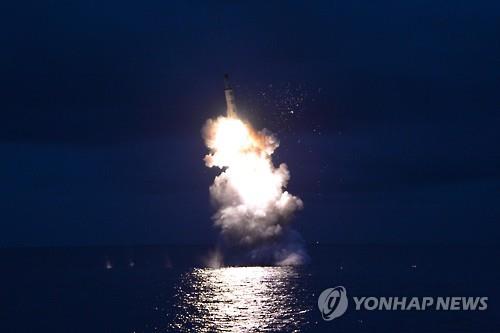- California Assembly OKs highest minimum wage in nation
- S. Korea unveils first graphic cigarette warnings
- US joins with South Korea, Japan in bid to deter North Korea
- LPGA golfer Chun In-gee finally back in action
- S. Korea won’t be top seed in final World Cup qualification round
- US men’s soccer misses 2nd straight Olympics
- US back on track in qualifying with 4-0 win over Guatemala
- High-intensity workout injuries spawn cottage industry
- CDC expands range of Zika mosquitoes into parts of Northeast
- Who knew? ‘The Walking Dead’ is helping families connect
Need to build nuke-powered sub rises as Seoul seeks to counter N.K. SLBMs
SEOUL, Aug. 26 (Yonhap) – The need for South Korea to possess a nuclear-powered submarine is increasing as the country moves to counter North Korea’s submarine-launched ballistic missile (SLBM) threat, military experts here said Friday.
They are emphasizing the necessity for Seoul to acquire a submarine with far greater endurance than conventional diesel-electric counterparts after North Korea test-fired an SLBM that flew about 500 kilometers earlier this week. This provocation, which is viewed as a “successful” launch, has fueled concerns about technical improvements in the reclusive country’s missile programs that can threaten global security.
Once a submarine goes underwater, it is hard to track. This makes it very difficult to determine when an SLBM will be launched, which can hinder a timely and effective response.
Many observers have said the best way to counter SLBM threats is to pre-emptively attack the missile-armed submarine in the event of an emergency situation.
If an SLBM is capable of carrying a small nuclear warhead, it can pose a formidable threat, as the North would be able to hit targets theoretically from anywhere with little warning, experts said.
“The only realistic way to counter SLBMs is to deploy a nuclear-powered submarine so they can maintain constant watch on a North Korean submarine base,” said Moon Keun-sik, an expert at the Korea Defense and Security Forum.
A diesel-electric submarine has to go up to the surface to recharge its batteries, which can expose it to detection by an enemy. A nuclear-powered sub does not have to do so and can stay submerged as long at it has fuel, making it possible to operate clandestinely underwater for a very long stretch of time.
The 2,000 ton-submarine model being used by North Korea is believed to be able to operate underwater for only a few hours and to possess only one ballistic missile silo within its sail.
Japan’s Tokyo Shimbun reported that North Korean leader Kim Jong-un has ordered the construction of a new submarine equipped with two or three launchers for SLBMs by September 2018.
A pro-North Korean newspaper based in Japan claimed that North Korea is in the final stages of deploying SLBMs for combat use.
The Chosun Sinbo said that the latest successful SLBM launch reaffirmed that the country is not far away from deploying the missiles operationally.
Analysts said that it would take some time for North Korea to improve on its existing submarine design or build a larger, nuclear-powered submarine for combat use.
The South Korean military reportedly has the capability to construct a small nuclear reactor for a nuke-powered submarine, but the problem lies in securing enriched uranium for fuel.
“We are closely watching the situation and share the need (to build a nuclear-powered submarine). But it does not look easy for us to do so immediately, given various factors,” said a military official.
A new atomic energy pact between South Korea and the United States permits Seoul to make low-enriched uranium that can be used as fuel.
Experts said that as the deal clinched in 2015 allows Seoul to enrich uranium at a low level for a “peaceful” purpose, Washington would not give its consent to South Korea’s possible move for a nuclear submarine.
It is possible to buy uranium with 20 percent of enrichment levels being traded in markets, Moon said.
“Solely from the technical perspective, I believe that the South Korean Navy has the capability to build such a sub within two or three years,” said Moon. “The government’s determination is critical.”
Boo Hyeong-wook, a chief research fellow at the Korea Institute for Defense Analyses (KIDA), made a similar claim at a forum held in June.
South Korea is seeking to build nine 3,000-ton submarines in three batches as part of its so-called Chang Bogo-III project. The move is aimed at building submarines with local technology that can better meet the country’s future defense needs.
Boo claimed that the nuclear energy pact with Washington would enable Seoul to design and build part of these submarines to have nuclear propulsion.












